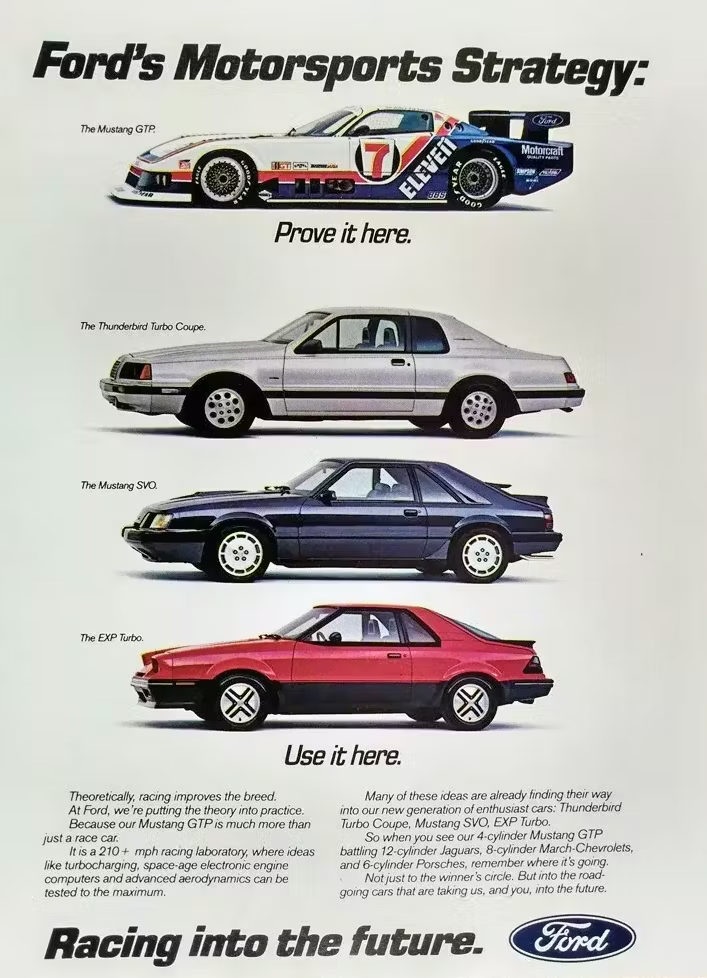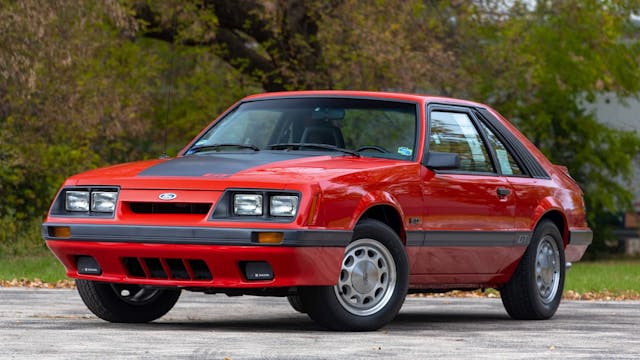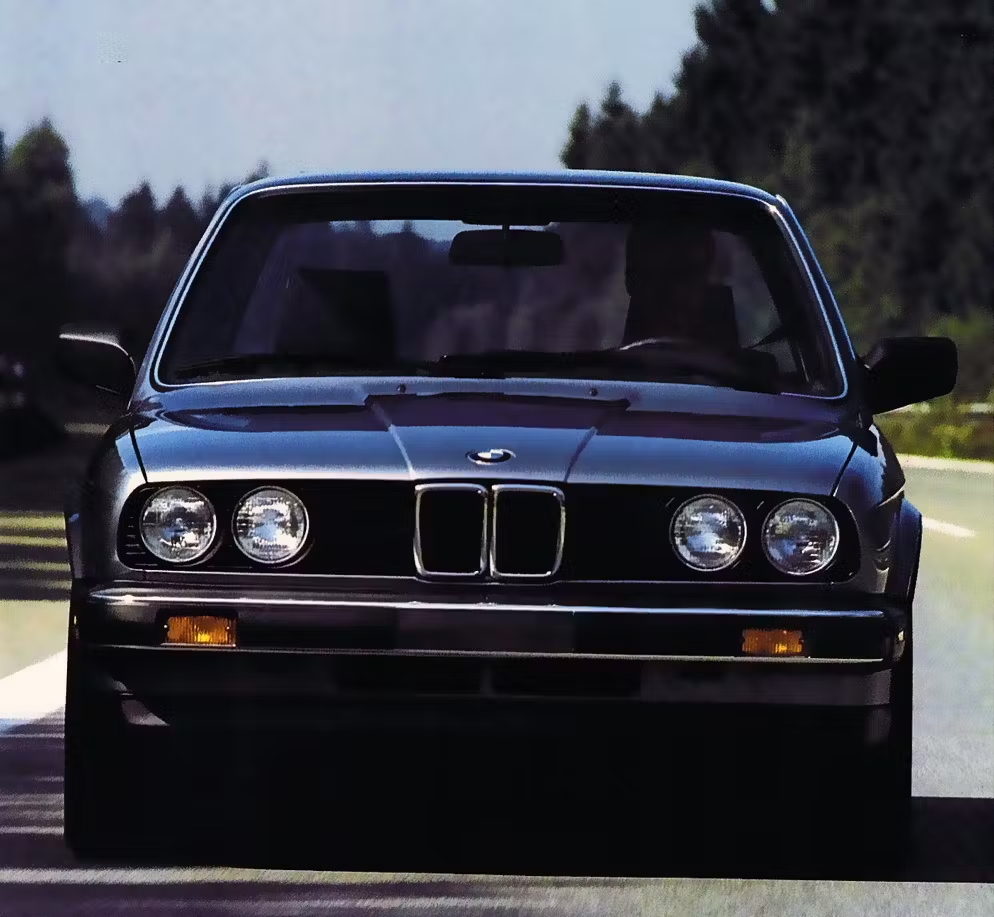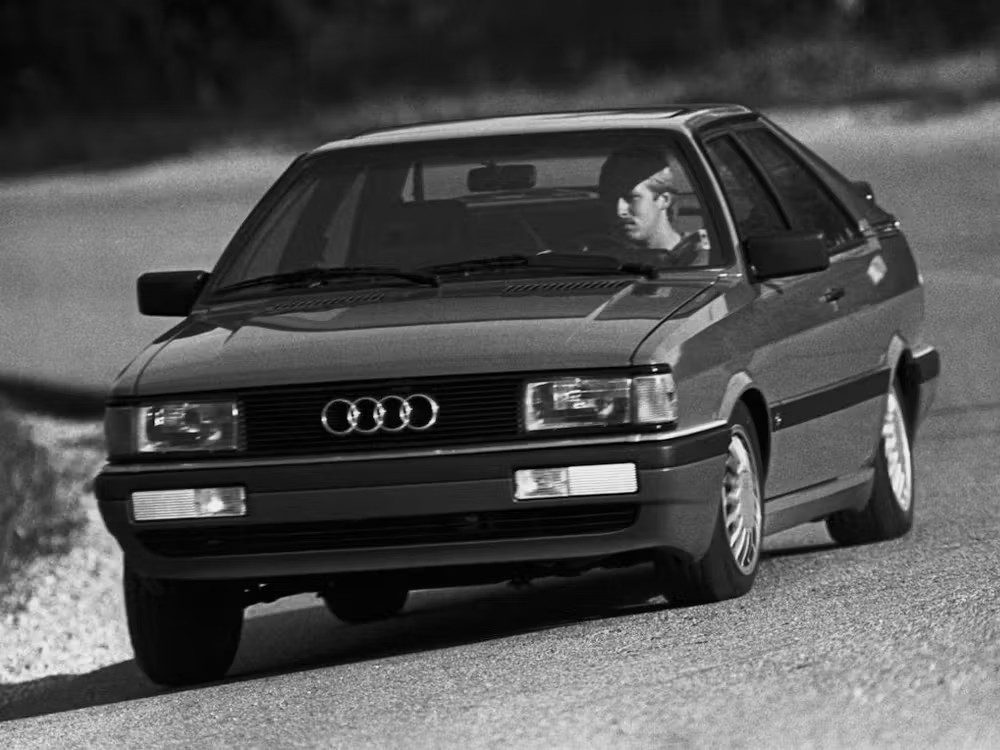Media | Articles
Turns out the Mustang SVO Won after All
The world got a little smaller on September 30, 1980, when the Ford Motor Company announced a new organization that consolidated independent operations into a singular concept, one that mirrored Ford’s long lost Total Performance era. This group signaled a rebirth of performance excellence for a storied automaker, and became another nail in the Malaise Era‘s coffin.
As David LaRocque wrote in MUSTANG SVO – The Machine Speaks for Itself, this group was the vision of journalist-turned-executive Walter Hayes. His idea had three components to consolidation: To put Ford back in various forms of motorsport, to create a catalogue of speed parts for enthusiasts, and to develop limited production vehicles that embody their passion for Total Performance.



This group earned a formal, MBA-grade name with a catchy acronym: Special Vehicle Operations, or SVO for short. Hayes aimed to elevate the Ford brand by leveraging ideas and assets already in use within the Blue Oval. We learn in MUSTANG SVO – The Machine Speaks for Itself that the “basic premise was to make this organization fiscally responsible.” The culmination of this mantra manifested in the only Ford vehicle to wear the group’s name on its flanks: The 1984-86 Ford Mustang SVO. While a bit compromised in concept and a slow mover in the showroom, prices show this oddball pony car to be quite desirable, after all. Even more so than much of its home-grown and foreign competition.
While the machine may have spoken for itself in promotional material, the story told is one of adhering to SVO’s mission of “fiscal responsibility” via parts bin upgrades and extensive refinements. Starting with Ford’s famous Fox platform, engineers improved the Mustang’s suspension with the 1982 Lincoln Continental’s long travel, cast iron front wishbones, six precise dampers from Koni (including two axle dampers), and surprisingly large 16 x 7″ alloy wheels. The prodigious disc brakes were lifted from said Lincoln, while the differential received a limited-slip and a quicker 3.45:1 axle ratio.
The powertrain was heavily based on the 1983 Ford Thunderbird Turbo Coupe, but added an intercooler fed by an offset scoop on the SVO’s unique hood. The improvements generated 175 horsepower and 210 lb-ft of torque, a full 20 horsepower more than the aforementioned Thunderbird. A Hurst shifter topped the Borg-Warner T-5 transmission, with a leather-wrapped knob for a touch of luxury.
Marketplace
Buy and sell classics with confidence


Higher end trimmings worthy of a world class performance car dotted the Mustang SVO’s carryover interior. The upgrades included heavily bolstered bucket seats with manually inflatable lumbar support via squeezable air pump. A three spoke steering wheel was leather wrapped and embossed with the SVO logo. A unique gauge cluster included a turbo boost gauge, 8000 rpm tachometer, and 140-mph “specially incremented” speedometer with empty hash marks above the federally mandated 85-mph limit.

External enhancements included unique bumpers, signal lights, aerodynamic spats ahead of the rear axle, pinstriped rear taillights, bi-plane rear spoiler (from the Ford Probe III concept) and the aforementioned scoop-infused hood. The SVO was the only Mustang of the “four eye” generation (1979-86) to wear a pair of conventional headlights, but even that was further differentiated during production. It’s clear that Special Vehicle Operations was doing everything possible to improve on a budget, offering more than what’s expected from a Mustang of the era.
Ford built a modest 4508 Mustang SVOs in its freshman year, partly due to a $15,585 price tag that was roughly $6000 more than a V-8 Mustang. But the air was ripe with potential, with performance impressive enough for Car and Driver magazine to suggest the SVO was “Ford’s Porsche 930 Turbo, an old design that’s kept vital with large doses of technology administered by dedicated engineer/racers.”

The next year of SVO production included a robust bump to 205 horsepower, thanks to items like a revised turbocharger, higher flowing fuel injectors, and a Mustang GT-like dual exhaust. Flush-mounted headlights similar to those on the 1984 Continental Mark VII were also implemented, but a disappointing 1954 SVOs were sold in 1985, and only 3382 shifted hands in 1986. The Mustang SVO died an unceremonious death, indirectly replaced by another fiscally responsible SVO creation, the well regarded 1987 Thunderbird Turbo Coupe.
Perhaps the Mustang SVO lacked the snob appeal of the European and Japanese competition it sought to challenge. Maybe the stick axle rear suspension and Ford Fairmont derived dashboard justified those downplays by the American consumer, as the need for unique/upscale accoutrements can’t be understated at such a lofty price point. The flip side of that coin was that the SVO was too expensive and slow in a straight line, relative to that of a Mustang GT.
But time heals all wounds, as now the Mustang SVO is reaching parity with its V-8 powered sister ships of the “four-eyed” Mustang generation. To wit, a 1985 SVO in #2 condition is worth the same $34,800 as a 1985 Mustang 5.0 notchback, and only $2,000-$5,000 cheaper than GT hatchbacks and convertibles of the same era. (Seasoned Mustang racers may scoff, but right now the numbers favor neither the track tuned SVO, nor the drag race ready Mustang LX ‘notch.)



Only the 1979 Mustang Indy Pace Car ($63,400) and 1984-86 Saleen Mustangs ($100,000+) are more valuable four-eyed fodder. But that’s only part of the story, as SVO engineers aimed this vehicle to sporty, premium priced imports of the day. So how does a 1985 Mustang SVO in #2 condition ($34,800) stack up against its intended competition from Europe and Japan?




These days a 1985 BMW 325e (the 325i came in 1987) in the same condition is only worth $22,800, or $12 grand less than our Mustang SVO. The BMW still trounces on the Audi GT coupe of the same year, as it’s “only” worth $19,700. The Nissan 300ZX is a mixed bag, as the naturally aspirated model is $16,500 but skyrockets to $41,900 for a turbocharged example. That makes the naturally aspirated 1985 Toyota Supra (turbocharging in 1987) somewhat of a standout, at $33,300 for all that Toyota quality.
A valiant effort, but the 1985 Mustang SVO spanks every intender aside from the turbocharged Z-car. Perhaps that isn’t a surprise, as only the boosted Nissan has enough horsepower to run with the Foxy Ford.

This story should not leave a bittersweet taste in the reader’s mouth, as Hagerty’s valuation data suggests Walter Hayes and his crew had the last laugh. Their hard work may not have paid dividends at SVO headquarters, but automotive history collectively thanks them all for the hard work, sleepless nights, and brilliant cost controls that brought the 1984-86 Mustang SVO to production.
Their turbocharged pony car was admittedly a bit rough around the edges relative to many imports in its class, but the collector car market knows what it likes: a rare Fox Body Mustang with turbo boost, Koni shocks, and an eye catching bi-plane spoiler. Congratulations to those gentlemen behind this machine, because you succeeded in the end.
***
Check out the Hagerty Media homepage so you don’t miss a single story, or better yet, bookmark it. To get our best stories delivered right to your inbox, subscribe to our newsletters.


























Meh…I thought about the SVO in 1985, but bought a Mustang GT instead; the SVO was just not worth the extra money (unless perhaps one regulary took it to the track), and as some have pointed out, did not have a good sound. And…I think that offset hood scoop would have always bothered me. ;<)
Interestingly, a Ford guy down the street has one in his collection. Nice to see one about, but I still don't want one.
Rider – I see a lot of cars, new cars, with perfectly centered hood scoops, that don’t do a damn thing and would serve no function even if you opened them up. That bothers me. Form Follows Function. The off set scoop works for me because it actually works and being asymmetrical in in this case fits.
My 1st new car in 1984 . Went in for a Tbird turbo or a GT & the dealer gave it to me for 12500 It was awesome for its time & coming back from stationed in europe it was quite the GT car. Quality was horrendous but you could get Mike K on the phone to tell the dealer to fix it . I bought a Z51 Vette the same year & my friends & I would race each other & the Vette would eat ts lunch, so much for magazine tests. I put 85k miles on the C4 with Zero issues & teh same clutch. I sold the SVO when the shifter fell off in my hand one rainy night.
The front wishbones from the Continental were aluminum, not cast iron.
As an owner of two of these Continentals, I can assure you they are cast iron.
The SVO was always on my list of interesting cars I’d like to own, until I got my XR4TI. Now it’s more of an inspiration than an aspiration. I still get the appeal of the SVO, especially it being a Mustang, but I don’t feel it offers more than what an XR offers comparatively, extra especially for the money. I suppose a OEM+ modified XR (ala Rapido or B.A.T.) just holds more appeal for me now.
Wyatt _ Does the gas gauge still work or do you just wait for the ‘Low Fuel’ light to come on ? Any leaks in the rack and pinion? Given the option,and all things being equal, I’d probably go with an XR4ti too. It’s decidedly different, but it would be a tough call to have to make.
The SVO Mustang was confusing the American car buyer. $6000 more for a four cylinder turbo? It wouldn’t be that secretive to figure out it originated from the Thunderbird.
Not sure what Ford was trying to say. The Mustang GT was king of the street with only an off road exhaust, cold air intake, under drives and 4:10s. All of this and more including support. So we are making a four cylinder Mustang and it’s better than a 5.0?? Not hardly. Much cheaper than the $6000 add for an SVO. Sad the trimmings of the SVO were not offered on the 5.0.
The whole SVO fiasco could have been avoided simply if Ford would have given the US market the Escort/Cosworth RS. In doing so would have given Ford the edge in the yet to happen tuner culture. To get in on a nice RS today expect to throw a minimum of $50K. They are remarkable and were only in the UK.
Unfortunately, then as today the 5.0 Fox is more reliable and more desirable. The SVO will always have its few fanboys. But let’s face it. The Mustang has always been about V8 power.
My SVO book from David LaRocque arrived today. Man, what a complete volume it is! Looking forward to reading it and having it in my library.
It’s definitely a must have for an 80s Ford fan. Glad you like it.